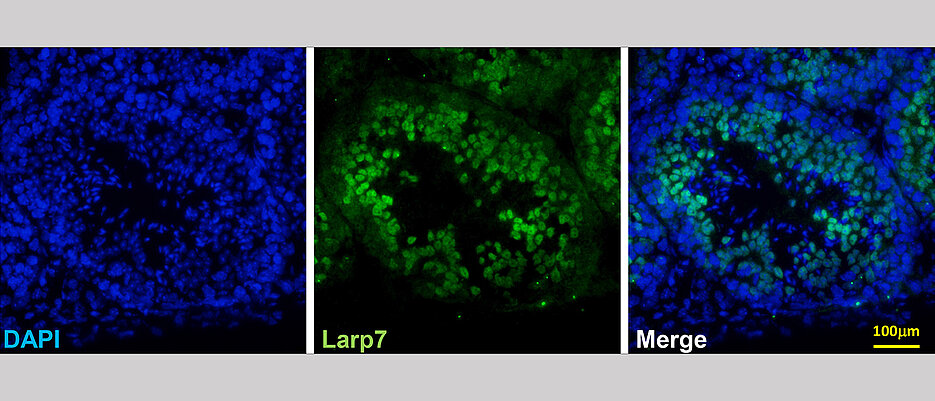Small mutation with serious consequences
02/05/2020Dwarfism and other developmental disorders are the consequences of a specific genetic defect. Researchers at the universities of Würzburg and Regensburg have now examined this gene in more detail.

It hit a family in Würzburg: Two of their members are affected by the Alazami Syndrome - a serious disease that manifests itself, among other things, through dwarfism and other developmental disorders. It is caused by a small mutation in the LARP7 gene, which has been known since 2012 to be responsible for this rare disease. Since then, about 20 cases of Alazami Syndrome have been identified worldwide.
Scientists from the Universities of Regensburg and Würzburg, in cooperation with the group of Mofang Liu from the Chinese Academy of Sciences, Shanghai, have now taken a closer look at the LARP7 gene and identified unexpected thus far unknown functions. This has now led to new insights into the molecular causes of Alazami Syndrome.
A team led by Utz Fischer, Chair of Biochemistry, and the Institute of Human Genetics at the Julius-Maximilians-University of Würzburg (JMU) were involved in the studies. The scientists have published their results in two articles in the current issue of Molecular Cell.
Role of gene in cell proliferation is not the whole story
"From earlier work, which was also carried out by several labs including ours it was already known that the LARP7 gene plays a role in transcription," explains Utz Fischer. Transcription: Anyone who still remembers biology lessons knows that this is the process in which the genetic information of the DNA in the cell nucleus is translated into messenger RNA (mRNA) by RNA polymerase. Only the mRNA strand is able to transfer the genetic information from the DNA to the sites of protein biosynthesis outside the cell nucleus. "This is what makes the genes capable of acting, because the information from the mRNA can then be used to create the necessary protein molecules," explains the Regensburg biochemist Professor Gunter Meister, who was also involved in the study that has now been published.
During transcription, LARP7 together with other factors acts as an inhibitor of elongation, i.e. as a kind of "brake shoe" on the elongation of mRNA by the RNA polymerase. Less functional LARP7 should therefore stimulate transcription and cause cell proliferation in the affected organism. "This made us wonder," adds Dr. Daniele Hasler, also a biochemist at the University of Regensburg, "because the patients with Alazami Syndrome display rather the opposite phenotype: they are small in stature. For this reason, the scientists have taken a closer look at the maturation of RNA.
Errors in the maturation process of RNA
In fact, the newly transcribed mRNA is not yet ready for translation; it must first "mature" - which means that certain parts of the mRNA first need to be removed. This is because a long piece of RNA contains many small sections that carry the genetic information, the blueprint for the desired protein molecule. At the same time, however, it also contains other information that is not necessary for the later translation into protein and therefore needs to be excised.
Surprisingly, the LARP7 gene is also involved in this process, which became apparent when the scientists switched off the gene. "We were able to see that with a deleted LARP7 gene the maturation of the RNA of certain genes is disturbed. This was also the case in patients affected by Alazami disease, and the altered genes are related to the development and expression of dwarfism," says Professor Meister.
That means that without LARP7, the RNA does not look the way it should look. "This made it clear to us that removing unnecessary information from certain RNAs is an important role of LARP7 and that mutations of this gene lead to Alazami disease," Dr. Hasler emphasis.
The folding is important
So far there is no chance of a cure for this rare hereditary disease. "That is why it is important that we learn more about this gene. We are continuing our research because we want to know why this small change is sufficient to cause such serious consequences," says Professor Utz Fischer.
For biochemists, RNA and in particular the LARP7 gene still holds many puzzles. There are indications that the gene has other functions. "For example, we know that LARP7 also helps RNA to adopt the right structure during the maturation process," says the biochemist. The idea of RNA molecules as long, cord-like strands is wrong; they actually have a complicated three-dimensional structure. And this spatial arrangement depends on the correct folding. "The shape is crucial for the RNA molecules to be able to perform a certain function," emphasizes Gunter Meister, adding: "We would like to understand this even better.






